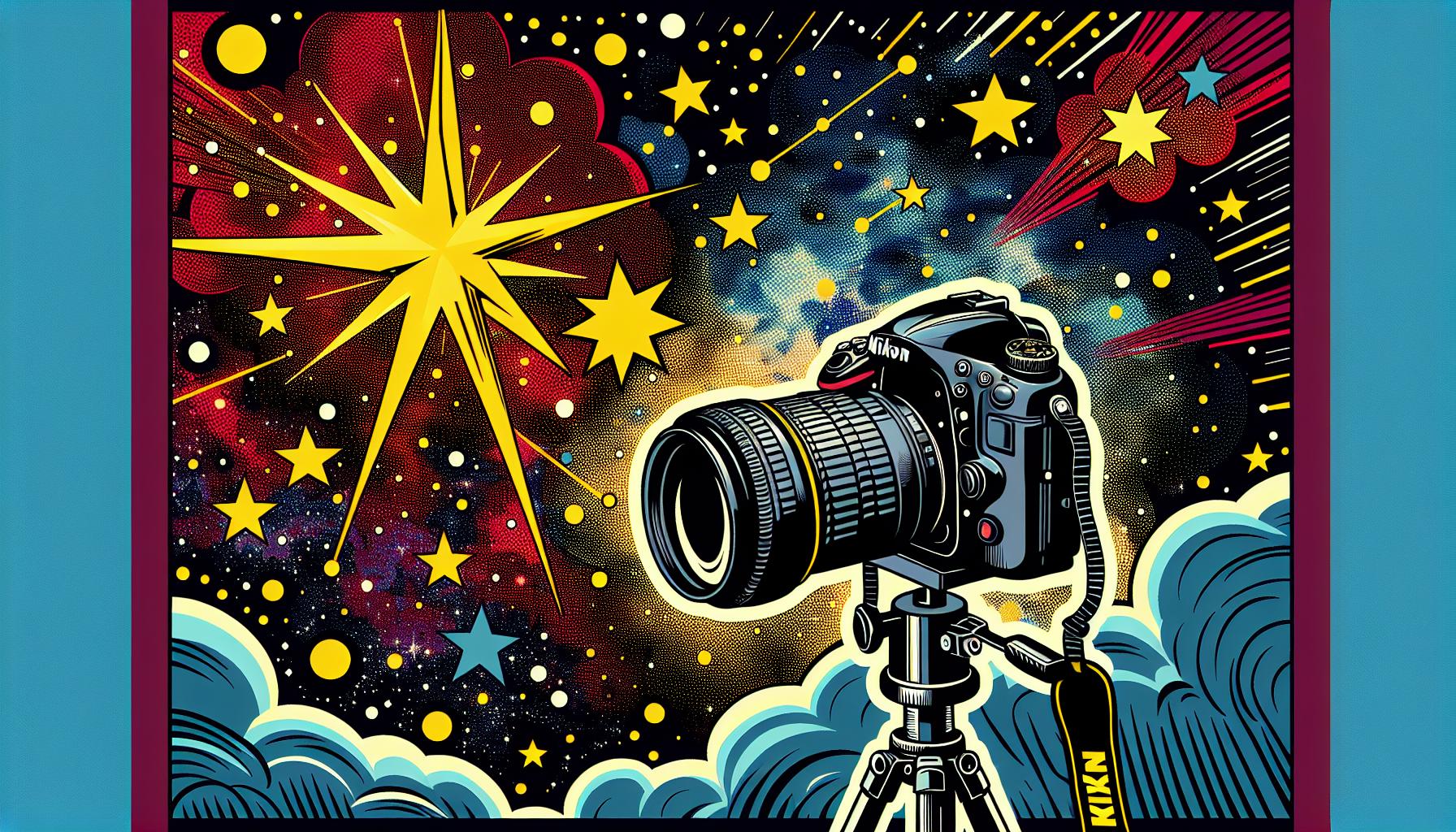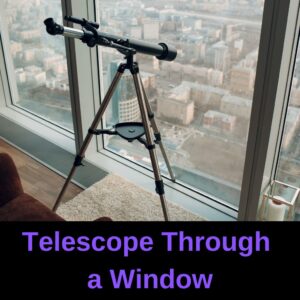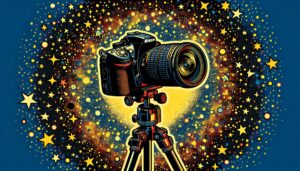This site contains affiliate links to products. I may receive a commission for purchases made through these links.
Astrophotography is a niche that’s growing in popularity, and Nikon’s range of cameras offers some excellent options for capturing the cosmos. Whether you’re a beginner or a seasoned pro, finding the right Nikon camera for astrophotography can make all the difference in your starry night shots.
Nikon has a reputation for high-quality cameras, and their models are often top picks for astrophotography. But with so many options, it can be tough to know which one is the best fit for your needs. In this article, I’ll walk you through some of the top Nikon cameras for astrophotography, comparing their features, performance, and price points.
So, if you’re ready to take your astrophotography to the next level and want to know which Nikon camera can help you do that, keep reading. You’re about to embark on a journey that will take you closer to the stars.
Nikon Cameras for Astrophotography: A Comprehensive Guide
Diving right into it, let’s explore the top Nikon cameras tailor-made for astrophotography and designed to capture the mystery and beauty of the night sky.
Nikon D850: With a high resolution of 45.7 megapixels, the D850 promises crisp, clear images. It excels in low light scenarios making it ideal for capturing the cosmos. When shooting long exposures, its silent shutter mode won’t introduce unwanted shake to your celestial shots.
Nikon D810A: The star of the show, Nikon D810A, is specifically designed for astrophotography. Its infrared cut filter allows for the capture of H-alpha red tones. It means you’ll be snapping distinct nebulae and galaxies, unlike any regular DSLR camera.
Nikon Z 7: Being a mirrorless model, the Z 7 offers a silent shooting mode, high resolution, and superb in-camera stabilization: all beneficial for astrophotographers.
Let’s review these models in a digestible format:
| Camera Model | Key Strengths |
|---|---|
| Nikon D850 | High Resolution, Low light performance |
| Nikon D810A | Optimized For Astrophotography, Infrared cut filter |
| Nikon Z 7 | Silent shooting mode, High resolution, In-camera stabilization |
Keep in mind, a camera is just one part of the equation in astrophotography. Complementing lenses, the right settings, and even the conditions of the night sky play an equally critical role. We’ll delve into these additional components further along in our discussion. Exploring these variables will equip you with a holistic understanding. Now that you’re familiar with some key Nikon models, it’ll be easier to align your specific needs and preferences with the right camera.
Why Nikon Cameras are Ideal for Astrophotography
When it comes to astrophotography, Nikon’s been a go-to brand for years. As a seasoned blogger, I’ve taken many night sky shots with a range of Nikon models – all with impresive results. So, why are Nikon cameras perfect for capturing celestial objects?
Through my experience, I’ve found that Nikon’s low light performance stands out. In astrophotography, the camera demands to extract detail from darker areas without elevating the noise levels. Nikon tackles this effortlessly. Models like the D810A, the D850, and Z 7 offer ISO ranges that comfortably stretch into the thousands, which allows photographers to lift their exposures without compromise.
Another invaluable Nikon feature in this night sky game is its sensor resolving power. A high-resolution sensor provides sharp captures of stars, giving you the necessary clarity in constellations, nebulas, or galaxies. We’re talking about sensors in the 36-45MP range that are present in Nikon’s aforesaid models. And the cumulative effect of these high-resolution sensors? Crystal clear images of the cosmos.
Invested in capturing the unearthly hues of nebulae? Then you’ll appreciate Nikon’s infrared cut filter – a feature specially designed for astrophotography. This filter in the D810A, for instance, increases its hydrogen-alpha sensitivity, rendering nebulae in wonderful, vibrant colors that are generally invisible to our naked eye.
But even with these stellar features, nobody’s suggesting Nikon’s the complete package for your astrophotography venture. One mustn’t overlook the significance of lenses, settings, and the sky’s condition on the final image. The right blend of these variables promises a rewarding stargazing expedition with your Nikon.
Factors to Consider When Choosing a Nikon Camera for Astrophotography
Let’s dive into the crucial aspects you need to consider while choosing the perfect Nikon camera for your astrophotography needs.
Sensor Size is crucial when capturing high-resolution images of celestial bodies. Nikon cameras offer both APS-C and full-frame sensor options. A full-frame sensor captures more light, giving you richer and detailed images even in low-light conditions. However, APS-C sensor cameras have a ‘crop factor’ that, while limiting the field of view, effectively magnifies distant subjects like stars and planets.
Another vital factor is the ISO Range. In low-light scenarios – the common setting for astrophotography – it’s beneficial to have a camera with a broad ISO range. It allows you to raise the ISO level without introducing too much ‘noise’ or graininess into the image.
Moving on, the Image Processing Engine also plays a significant role. The engine’s efficiency directly impacts the rate at which the camera can process images.
Lastly, don’t underestimate the importance of the camera’s build. For outdoor activity like astrophotography, you’ll want a camera that is rugged, durable, and preferably weather-sealed.
And while we’ve focused on Nikon cameras, remember this – no matter the choice of your camera brand, a high-quality lens, precise settings, and the night sky’s condition remain paramount.
| Nikon Camera Factors | Importance in Astrophotography |
|---|---|
| Sensor Size | Captures detailed, low-light images |
| ISO Range | Adjust light sensitivity without introducing noise |
| Image Processing Engine | Quickly processes high-resolution images |
| Camera’s Build | Must be durable and weather-sealed |
Top Nikon Cameras for Astrophotography
Switching gears a bit, let’s now delve into the actual Nikon models that stand out in the field of astrophotography. The variety in Nikon’s range means there’s something for everyone, from the casual stargazer to the seasoned astrophotographer. So here are some Nikon cameras that impress me the most.
Perhaps the first model that springs to mind is the Nikon D810A, an astrophotography-specific DSLR. Designed explicitly for capturing the cosmos, this camera has a modified infrared cut filter that maximizes hydrogen alpha light transmission. This allows the camera to deliver stunningly sharp images of nebulae that can’t be easily achieved by unmodified cameras.
Next on our list is the Nikon D750. This full-frame DSLR offers an impressive 24.3 megapixels and an ISO range of 100 to 12800. It’s this extended ISO range, paired with excellent low light performance, that makes the D750 perfect for capturing the night sky.
For those who prefer mirrorless cameras, the Nikon Z6 might be your best bet. Like the D750, it’s equipped with a full-frame sensor but it’s the camera’s newer, faster image-processing engine that really shines. Combined with the higher ISO range, it outruns many rivals in image quality and low light performance.
I can’t forget the Nikon D5600, an ideal entry-level option for budding astrophotographers. With its ease of use and budget-friendly price tag, it caters effectively to the needs of novices before they decide to upgrade.
Between these cameras, the right one for you boils down to your specific needs and budget. But remember, regardless of the camera you choose, your lens, settings, and of course, the night sky conditions hold the keys to those awe-inspiring images of the cosmos.
Comparison of Key Features and Performance
Starting with the Nikon D810A, this camera was built specifically with astrophotographers in mind. Its modified infrared cut filter is unparalleled in the realm of astrophotography, primarily designed for capturing nebulae that emit on the H-alpha wavelength. It’s got a 36.3-megapixel FX-format CMOS sensor, giving users high-resolution images.
Moving on to the Nikon D750, it’s a fantastic DSLR for low light shooting with its maximum ISO being 51200; it provides stunning image quality even in near darkness. It also comes with a 24.3-megapixel FX-format CMOS sensor offering excellently detailed images.
Let’s not forget the powerful Nikon Z6. This camera features a newer image-processing engine, EXPEED 6 and a 24.5-megapixel sensor. It boasts a high ISO sensitivity range, top-notch speed and resolution. Its in-body image stabilization ensures crisp images, even under low-light conditions.
Last but not least, the Nikon D5600 provides a budget-friendly option for beginners in astrophotography. It’s got a 24.2-megapixel sensor coupled with an impressive dynamic range and a respectable ISO range. It’s undoubtedly a solid performer.
Here’s a quick summary of their key features:
| Camera | Sensor | ISO Range | Special Features |
|---|---|---|---|
| Nikon D810A | 36.3 MP FX | Base ISO 200, expandable to ISO 51200 | Infra-red cut filter |
| Nikon D750 | 24.3 MP FX | ISO 100 – 51200 | Great for low light shooting |
| Nikon Z6 | 24.5 MP FX | ISO 100 – 51200 | Image-processing engine, high ISO sensitivity range |
| Nikon D5600 | 24.2 MP DX | ISO 100 – 25600 | Budget-friendly, good for beginners |
Remember, the perfect camera will depend on your needs and proficiency level in astrophotography. It’s essential to consider factors like your budget and your level of familiarity with the camera’s settings, not just the camera’s specifications.
Accessories and Equipment for Astrophotography with Nikon Cameras
Getting stunning astrophotography shots with your chosen Nikon camera, whether it’s the D810A, D750, Z6, or the D5600, requires more than just the camera itself. Here, we’ll delve into the essential accessories and equipment that can enhance your night sky photography experience.
A necessary accessory for capturing clear, crisp images of the night sky is a sturdy tripod. Stability is key in astrophotography, and a tripod ensures your camera stays motionless during the long exposure times required to capture those breathtakingly detailed images. The last thing you’d want is blurred or shaky images.
Your camera’s built-in lens can affect your astrophotography results significantly. A rule of thumb is to go for lenses with wide apertures and low focal lengths. These lenses allow more light to enter the camera, capturing the faintest stars. Known as “fast lenses”, they are perfect for astrophotography.
Remote shutter releases are useful tools for shooting long exposures in astrophotography. They allow photographers to start and stop exposures without touching the camera, reducing the risk of camera shakes which can ruin your shot.
The right settings and conditions can also make a world of difference. Weather is one crucial factor often overlooked by newbies. Clear skies are best for astrophotography, as clouds, fog, or other weather disturbances can obscure the celestial objects you’re trying to capture.
In terms of settings, every scenario may demand a different approach but generally, higher ISOs and longer exposure times are encouraged in astrophotography. However, it’s a balance act – keeping the ISO too high might introduce noise to your photos, and exposure times that are too lengthy may result in star trails rather than pinpoint stars.
It’s essential to remember – no accessory can replace knowledge and practice. Understanding how your Nikon camera and chosen lens work, how to utilize different settings, and how to read the nocturnal weather can greatly enhance your astrophotography skills. This journey towards mastering astrophotography with a Nikon camera is about trial and error and continuous learning.
Tips and Techniques for Astrophotography with Nikon Cameras
Now that we’ve discussed the array of Nikon camera options for capturing the night sky, let’s delve deeper. I’ll equip you with proven techniques and handy tips that’ll enhance your astrophotography journey using Nikon cameras. Be ready to capture mesmerizing celestial observations like a pro.
Our first stop is Setting Up Your Nikon for Astrophotography. You’ll want to optimize your Nikon’s settings to best capture those elusive stars. Here’s a breakdown of what I recommend:
- ISO. Start with an ISO setting of around 1600. It can go higher if your camera can handle it, but beware of the noise that comes with high ISOs.
- Aperture. Opt for a wide aperture, the wider the better. It’ll allow more light to hit your sensor, perfect for capturing dimly lit skies. F/2.8 or wider is ideal.
- Shutter speed. You’ll want to keep the camera’s shutter open for longer periods. Experiment with different lengths but keep in mind, too long and you’ll see star trails.
Now let’s move to the Choosing a Lens for Astrophotography segment. The right lens can make a significant difference in astrophotography. Opt for a lens with a wide aperture and low focal length. Here are my top three picks:
- Nikon 14-24mm f/2.8
- Nikon 24-70mm f/2.8
- Nikon 20mm f/1.8
Each offers excellent low light performance, so choose based on your budget and preference.
Lastly, Patience and Practice are key. Astrophotography requires patience. A single shot may require long exposure times and several attempts. Always experiment with different settings, locations, and weather conditions. It’s also important to continually learn and adapt, as astrophotography is as much about understanding the heavens as it is about knowing your camera.
The quest for stellar images never has an end point, each shot offers a unique learning experience, so keep exploring, keep learning.
Conclusion: Choosing the Best Nikon Camera for Your Astrophotography Journey
Finding the right Nikon camera for your astrophotography needs isn’t a decision to take lightly. It’s about understanding your requirements and choosing a model that aligns with them. Remember that the best camera is the one that you’re comfortable using and meets your specific needs.
Optimizing your camera settings is crucial. You’ll want to master the balance between ISO, aperture, and shutter speed. A lens with a wide aperture and low focal length can be a game changer.
But don’t forget that astrophotography is as much about the journey as it is about the destination. It’s about patience, continuous learning, and the thrill of capturing the cosmos. So keep exploring, keep learning, and most importantly, keep shooting. The night sky is waiting for you.
Frequently Asked Questions
What is the best Nikon camera setting for astrophotography?
Based on the article, optimizing your camera settings is crucial. Use a high ISO, wide aperture, and a slower shutter speed to effectively capture stars. Keep experimenting to find the best combination for your specific scenario.
What type of lens is recommended for astrophotography?
The author suggests choosing a lens with a wide aperture and a low focal length. These characteristics allow better light sensitivity and a broader frame for capturing the vast night sky.
Why is patience important in astrophotography?
Astrophotography requires patience as the perfect shot does not come immediately. It’s key to practice and learn continuously. Frequent experiments can lead to better results, helping you achieve stellar images.
How should one start learning astrophotography with a Nikon camera?
The author recommends starting by understanding and optimizing your camera’s settings. Following that, selecting a suitable lens for astrophotography must come next. Finally, practicing patience and continuous learning will help you perfect your astrophotography skills.




